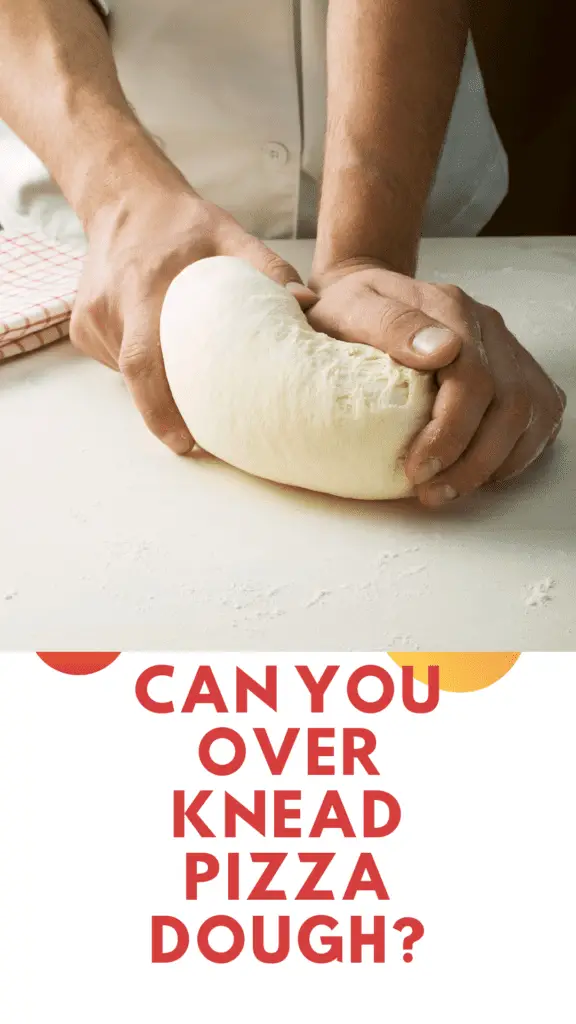If you recently made pizza and realized that the crust has a lot of faults in it, it’s natural for you to begin tracing back where you made the error.
Could it be that you over kneaded the pizza dough? — Is there ever such a thing as an over kneaded dough to begin with?
If you can over knead a pizza dough, can you also under knead it?
These are some of the questions we’ll be answering in this article. And to do that, we’ll be exploring the chemistry behind dough making first, which will then allow us to understand how (if possible) a pizza dough can be overworked.
Without wasting much time, let’s get started.

What Happens If You Over Knead Pizza Dough? And What Does An Over Kneaded Pizza Dough Look Like?
Before we begin to tackle the question of what happens when we over-knead a pizza dough, let us first grasp the concept of dough making and understand what happens in the process.
So what happens when you knead a dough? And why is it even necessary? (I known right? A very funny follow up question!)
When you mix all the wet and dry ingredients in a mixing bowl for the purpose of making a dough, the main goal is to develop a strong network called gluten whose strength and organization depends on how well the kneading is done as well as for how long.
It is this network that gives the dough its elasticity, rise and structure.
Because of this, it is critical, therefore, to ensure that the network is developed just right so that the dough bakes out perfectly, and one way to ensure that is to avoid over kneading. Or, to knead properly.
Yes, pizza dough can be over kneaded and the result when baked is a crust that breaks apart easily (especially in the middle which holds the toppings) or one that bakes unevenly or bakes into a dense and hard crust.
The chemical explanation for these issues is the fact that the gluten network becomes too tight and rigid which makes the dough tough and tear-prone.
As for what an over kneaded dough looks like, I can only tell you what it feels like, because its looks are indistinguishable from a properly kneaded dough.
So how does an over kneaded dough feel like?
An over kneaded dough feels tough or dense to the touch, doesn’t give that much when poked with a finger and isn’t easily shaped on a flat surface because it snaps back quickly or ends up breaking.
How To Fix An Over Kneaded Dough?
To be very honest, there really isn’t much you can do to salvage and over kneaded dough.
All efforts to try and make it usable can turn frustrating, futile or worse, ruin the dough.
When you have an over kneaded dough, the best you can do is to allow it to rest for a while and see if the gluten network relaxes to the point where the dough becomes smooth and easy to work with.
If it doesn’t, then it’s best to start all over again making sure you pay close attention to the speed of kneading as well as the duration when working with machine or hand respectively.
What To Do With An Overworked Pizza Dough?
When you have an over kneaded pizza dough that proves unsalvageable even with all your resting efforts, then there are a few ways you can use it to avoid wastage.
The first thing to do is to use it as a base for making more forgiving dough recipes like calzones, breadsticks or flat breads.
You can also use small chunks of it as a starter for making the new batch of pizza dough.
Another way you can purpose it is into the compost where it will first grow moldy before breaking down into a finished compost.
What you should never do with an overworked pizza dough, however, is to attempt to feed your pets or livestock with it without first consulting with a veterinary doctor.
In dogs for example, it can cause swelling of their stomach and cause the release of toxic levels of ethanol into their bloodstream.
So be someone who always makes an informed decision and not someone who just acts based on instincts.
How To Tell If Pizza Dough Is Kneaded Enough?
We’ve talked about over kneading your dough and what it looks and feels like.
Now we’ll discuss a perfectly kneaded dough and the ways that you can recognize it.
First, your dough will have a smooth structure throughout and will be free from flour spots or lumps. Then, it will be elastic when pulled to demonstrate the strong presence of a gluten network but will not tear or snap back fast.
The dough would also feel slightly sticky but not completely wet (the latter which is an indication of the usage of too much water in the dough mixture).
Another sign of a properly kneaded dough lies in the way that it rises when proofed.
If it has a strong and well developed gluten network, then it would almost always double in size when left to ferment in as little as an hour or two. Because the network is strong, yet extensible.
And when this “swollen” dough is poked with the finger, it will only slowly erase the indentation and not quickly spring back. If the dough holds in the indentation without springing back, then it may have been over kneaded or require more kneading.
If you notice that the dough is easy to shape and doesn’t offer too much resistance, then that is also a good sign that it has been kneaded properly.
How Long Do You Need To Knead Pizza Dough?
Generally speaking, pizza dough doesn’t require so much time kneading and that is primarily because it is made using flour that has low gluten content, even though the protein content may be high.
On average, pizza dough should require 8 to 10 minutes of kneading by hand to form into a smooth and elastic form that doesn’t stick to the hands.
When using a food processor, it should take between 1 to 2 minutes and that considering the fact that you’re making the dough from scratch inside the processor, and when using the kitchen aid mixer, it should require close to 8 minutes of kneading time.
When using a flour with more gluten content in it, like the bread flour, it may require an extra minute or two of kneading to really form the desired dough consistency.
But make sure to always pay close attention to the visible signs of a properly kneaded dough that we have outlined above, and when you notice them, stop kneading!
Is There Such a Thing As An Under Kneaded Pizza Dough?
Yes, there is such a thing as an under kneaded dough, and the problems it causes are far more annoying and unpredictable than over kneading.
Under kneaded dough would never bake into the right type of structure you want for your pizza: soft, light and airy, and that is because the gluten network is poorly formed which means that air cannot be trapped inside the dough.
Almost always, under kneaded dough bakes into a crust that is too dense or oddly chewy and would not complement well with the pizza toppings.
We have described how a pizza dough feels and looks when it’s properly done, make sure to be on the look for these signs and avoid anything outside of it.
A foolproof way is to ensure that you always follow a recipe, that way, you know how much time to knead the dough before you wrap it up for proofing.
Do You Knead Pizza Dough After It Rises?
No, you don’t need to knead pizza dough after it rises.
You only shape it into a rod, cut it up into smaller sizes, shape them into balls and allow them to proof for additional hours before baking them into pizzas.
Kneading the pizza dough a second time increases the likelihood of over kneading which can have the consequences as we have mentioned above.

